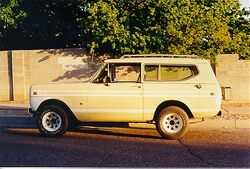 | |
| Manufacturer | International Harvester |
|---|---|
| Production | 1961–1980 |
| Class | Full-size SUV |
| Body style(s) | 2-door SUV, Pickup Truck |
| Layout | Front engine, rear-wheel drive / four-wheel drive |
The International Harvester Scout was one of the first production American civilian off-road sport utility vehicles. It was originally created as a competitor to the Jeep, and like that vehicle, early models featured fold-down windshields. The first generation Scout and second generation Scout II were produced as two-door vehicles with options of a half cab pickup truck or a removable full hard or soft top. Scouts were manufactured from 1961 to 1980 in Fort Wayne, Indiana.
Origin[]
International Harvester had been building trucks, pickups and later Travelalls since 1907. In the late 1950s, they began a design plan to produce a vehicle to compete with the Jeep CJ. By late 1960 the first Scout was available: the Scout 80, with a 1961 model year.
According to Ted Ornas, the chief designer of the Scout,
...the market potential for a 4 wheel drive recreational vehicle was an unknown quantity in the early 1950s. The only such vehicle offered in the post-war period was the Willys Jeep, a version of the military jeep produced for World War II. It was a flat-sided bare-bones product, and American military personal learned to appreciate its ability to maneuver over rough terrain. Sales volume was very low. In early 1958 we were directed to develop a concept proposal to enter this small market of that time. So help me, Mr.Reese, manager of engineering, said 'design something to replace the horse.' There was no product definition to use as a guide. It was even proposed to use the defunct Henry J body tooling. Compound body surfaces were considered too far out for this type of vehicle. The military jeep was thought to have the correct appearance. Our design sketches with the flat-side, no contour look never excited the executive committee. The program began to die. One night while sitting at our kitchen table (full of frustration and desperation), I dashed off this rough sketch on a piece of scrap mat board. It had contoured sides and was designed for plastic tooling. The next morning it was shown to a committee member. He reviewed it with controlled enthusiasm, but revived interest in the program. We were off and running. Goodyear produced many plastic parts for WWII and had formed a large plastic engineering group. We entered a program with them, a scale model was vacuum formed to simulate body assembly. This model received executive approval for appearance. By July 1959, Goodyear completed their costing and, because of the high costs, the plastic program was cancelled. By this time the contoured design met with executive approval and a decision was made to convert the body design to steel. Starting in late July 1959 a full size [[clamodel was completed, and in November 1959, it was approved. Looking back, it was a remarkable program with fast paced engineering and manufacturing developments. The total development time of 24 months was an heroic achievement considering the concept was unique and no in-house engine or manufacturing was available or even considered when the program started.
"The first Scout was introduced in 1960. A concept for its replacement was initiated in 1964 and approved for production in mid 1965. The Scout II was introduced in 1971. The basic sheet metal remained the unchanged until production stopped on October 21, 1980. During the 20 year period (1960-1980) 532,674 Scouts were produced. The Scout, introduced as a commercial utility pickup in 1960, set the stage for future 4-wheel drive recreational vehicles of the '70s, '80s, and '90s.
Scout models and variants[]
There were several production models of the Scout:
- Scout 80, 1960-1965/Scout 800,1966-1971(1961–1971):The original production model
- Scout 810 (1971): Some early Scout II's contain Scout 810 badging on the glove box.
- Scout II (1971–1980): The later standard production model with a removable soft or hardtop (100 inch wheelbase).
- Scout II Terra (1976–1980): The light pickup truck version (118 inch wheelbase).
- Scout II Traveler (1976–1980): This version had a removable fiberglass hardtop, optional third row of seats (118 in wheelbase).
- Super Scout II (SSII) (1977–1979): This model had removable fabric doors, a rollbar, and softtop. The Soft-top model was tagged the "SSII" by IH marketing. Eventually the "SS" letters were assumed to stand for "Super Scout", the name this model is called today.
Scout 80[]
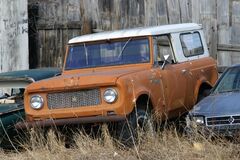
4/4 Scout 80 with Traveltop and lift
 Example of 1961 Scout 80 | |
| Manufacturer | International Harvester |
|---|---|
| Production | 1960-1965 |
| Successor | International Harvester Scout 800 |
Scout 80s were built between 1960 and 1965. These models were identifiable by removable sliding side windows in 1960–1961 and even some very early 1962 models, a fold-down windshield, vacuum windshield wipers mounted to the top of the windshield and an IH logo in the center of the grille. The Scout 80 had the gasoline-powered 152 4-cylinder as its standard engine.
- Red Carpet Series
The first special package was the "Red Carpet" Series, celebrating the 100,000 Scout manufactured by IH. This model had a red interior with a white exterior, full length headliner and full floor mats, and a special medallion affixed to the door which read, "100,000 Red Carpet Series Scout By International".
- Scout 80 Camper/Motorhome
In the early 1960s International experimented with a camper body permanently mounted to the Scout 80. The roof was raised to nearly double the original height (to allowed standing upright inside), tented sleeping bunks folded out of the sides, and the rear of the body was extended significantly. The tailgate/liftgate system was replaced with one large ambulance-style swinging door. Plans included that the unit could be purchased as a stripped down shell ($960 installed), or as a "deluxe" unit, which included a dinette set, stand up galley, and a screened chemical toilet that retracted into the wall ($1850 installed). The May 1963 issue of Mechanix Illustrated contains a full color ad for the Scout Camper on the inside cover, which features two artist's renderings of the unit and a form to fill out and send in for free literature. The camper shows up again in the May 1963 issue of Popular Science, this time in an actual photo as part of a two-page article about pickup campers. The photo proves that at least one unit existed, but it is not known if they were ever produced or available to the public.
Scout 800[]
| Manufacturer | International Harvester |
|---|---|
| Production | 1965-1968 |
| Predecessor | International Harvester Scout 80 |
| Successor | International Harvester Scout 800A |
The Scout 800 replaced the Scout 80 in late 1965. 800s were built from late 1965 to 1969. These models had many improvements in comfort and design, including bucket seats, better instrumentation and heating systems, updated dashboard, optional rear seats, and optional 196 4-cyl, 232 6-cyl, or 266 V-8 engines. A turbocharged version of the 152 4 cylinder (the 152-T) was offered from 1965–1967. The fold-down windshield was eliminated, and the vaccum wipers were moved to the bottom of the windshield frame.
IH also offered the Scout 800 Sportop, which had an upgraded interior and a unique fiberglass top (also available as a soft top) with a slanted rear roof and a continental spare tire kit. The "Champagne Series" Scout was a high-option Scout offered in the Scout 80 and later Scout 800 models.
Scout 800A[]
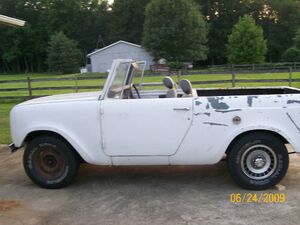
Unrestored '69 800A Scout
| Manufacturer | International Harvester |
|---|---|
| Production | 1969-1971 |
| Predecessor | International Harvester Scout 800 |
| Successor | International Harvester Scout 800B |
1969 saw the introduction of the 800A, which replaced the 800. Improvements included more creature comfort options, a slightly different front end treatment, drivetrain upgrades (heavier rear axle and quieter Dana 20 transfer case) and the options of: 196 4-cyl., 232 6-cylinder, 266 V-8,or the 304 V-8.
The 800A could be ordered with the SportTop(A slanted sporty top made of canvas or fiberglass) and Aristocrat, Comanche, SR-2, and Sno-Star packages.
Scout 800B[]
| Manufacturer | International Harvester |
|---|---|
| Production | 1971 |
| Predecessor | International Harvester Scout 800A |
| Successor | International Harvester Scout II |
The last of the 800 series was the 800B, available for only part of 1971 before it was replaced with the Scout II. Identical to the 800A other than in minor cosmetic details, it was produced only until the Scout II was in production.
The 800B was available with the Comanche package. This package included special paint and decals, chrome trim, sliding travel top windows, and other "high dollar" options such as roof racks, chrome wheels, and upgraded interiors. Line tickets of the special package Scouts (and some non-package units)were stamped. After the factory assembles the vehicle and the vehicle is shipped and sold, the Lineticket identifies such things as the engine type, transmission type, drive line, paint codes, gear ratio, and standard and optional equipment, specific to that vehicle. This was and still is a very valuable tool when ordering parts later at the dealership by the customer.
Scout II[]
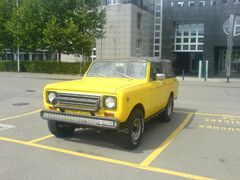 International Harvester Scout II 1978 | |
| Manufacturer | International Harvester |
|---|---|
| Production | 1971-1980 |
| Predecessor | International Harvester Scout 800B |
| Successor | none |
| Transmission(s) | 3-speed manual |
| Wheelbase |
100.0 in (2540 mm) 118.0 in (2997 mm) (Terra & Traveler) |
| Length |
165.2 in (4196 mm) 183.2 in (4653 mm) (Terra & Traveler) |
| Width | 70.0 in (1778 mm) |
| Height | 67.2 in (1707 mm) |
| Curb weight |
3,391 lb (1,538 kg) 3,439 lb (1,560 kg) 3,583 lb (1,625 kg) 3,609 lb (1,637 kg) |
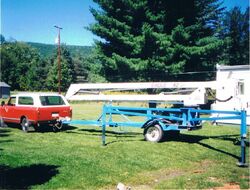
'76 Scout Traveler
Scout II's were manufactured from mid-year 1971 to 1980. The Scout II is most identifiable by its different front grilles. The 1971–72 Scout II shared the same grille, three horizontal bars between the headlights and chrome rings around the headlights. 1973 Scout II's had 14 vertical bars between the headlights, a split in the middle, seven bars on each side surrounded by chrome trim pieces and an "International" model plate low on the left side. 1974–75 Scout II grilles were the same as 1973, with the addition of a vertical bar trim overlay. The 1975 had chrome & black square trim rings around the headlights. 1976 had the same headlight trim rings as 1975, a chrome center grille of 15 horizontal bars split into three sections was used in this year only. 1977–79 Scout II's used the same grille between the same headlight bezels the new chrome grille had two large horizontal bars with three vertical support lines and the "International" nameplate moved up to the center of the grille on the left side. In 1980, the final year of production for the Scout, the grille was a very distinctive design, available with black or silver, a one piece grille with square headlights, made of ABS plastic. Both grille color options had imprinted chrome trim around the headlights and an "International" name located on the left side. Starting with late 1974 Scout IIs disc and power brakes were standard features. Early 1974 models had disc brakes as a rarely selected option.
Scout II Terra & Traveler[]
The Terra and Traveler were produced from 1976–1980. Terras and Travelers had fiberglass tops; half top for the Terra or full top with hatchback type liftgate on the Traveler. Most notably different, these models were extended by 18" in the region between the door and the front of the rear wheel well.
Scout SSII (Soft-top Safari II)[]
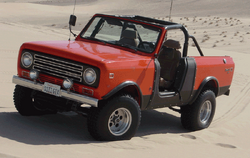
IH Scout II, with SSII Doors
The SSII (Super Scout II) was built from 1977 to 1979 in order to compete with the Jeep CJ. This model included a soft top with soft doors, Jeep style mirrors, plastic door inserts, special plastic grille and a roll bar, among other options. Several SSIIs were champions on the off-road racing circuit during the late 70s.
Special packages offered on the Scout II[]
Shawnee Scout[]
The Shawnee Scout was to be a trim type and special feature package model produced by Hurst Performance. This model was built by dressing up a black SSII with special tomahawk and feather decals, special seats, a black targa style top, hard tonneau bed cover, and of course a Hurst shifter. Only three or four Shawnee Scouts were produced.
CVI: Custom Vehicles Incorporated[]
CVI: Custom Vehicles Incorporated (also associated with Good Times, Inc.) was a company (located around the corner from the Ft. Wayne Scout Assembly Plant) that produced special models for IH dealers in 1979 and 1980. These were dressed-up Scout models with special exterior decals and trim, center console coolers, hood scoops, and some editions had plastic window louvers on the rear side glass, fender flares, and two different plastic tailgate inserts. Model names included the Midnitestar, Terrastar, Travelstar, Shadow, Raven, two Classic models, GMS (Green Machine Sport), GMS (Gold Medallion Scout), Hot Stuff, Trailstar, Sportstar, 5.6 Liter & 3.2 Liter models.
The "Selective Edition" Scout II[]
This was a special package available from the factory. 1978–79 package order code on the lineticket was 10992. The package included special gold accent stripes, gold spoke wheels with Goodyear Tracker A-Ts, SSII black grille insert, and Sport Steering wheel. Other options available: Choice of powertrain, seats, interior, radios, cruise control, tow packages, AC, all available in exterior colors 1032 Dark Brown, 6027 Dark Blue, 001 Black, 5013 Green. This was available on the Travel top, Traveler and Terra models.
"Spirit of 76" and the "Patriot" special editions[]
For the USA Bicentennial in 1976, IH produced the Spirit of 76 and the Patriot models. The Spirit of 76 had a special blue soft top and blue/red side applique and was only available on the Scout II. The Spirit also had blue interior, racing-type steering wheel and 17" inch chrome rally wheels. IH data only shows 384 Spirit models ever being built. Lineticket codes included:
10876 for the side applique. 18696 to omit the hard top. 16928 Deluxe interior. 16872 blue interior color. 9219 Winter white exterior paint. 885102 10-15 front tires. 925102 10-15 Rear tires with spare. 29091 7" chrome wheels.
The Patriot had a hard top and the same blue/red side applique, but was available in a Scout II, Terra or Traveler. Sales figures on the Patriot only show 1 Terra, 7 Travelers, and 50+ Scout IIs were manufactured. However there were another undetermined number of Patriots built without Lineticket code designations (the applique was applied at the TSPC (Truck Sales Processing Center)) making it difficult to know just how many were actually built. Nevertheless, both models can be considered extremely rare.
The "Midas Edition" Scout II[]
From 1977 to 1980 IH contracted with Midas Van Conversion Co. of Elkhart, Indiana, to build special luxury models to be offered through its dealers. These vehicles had swivel bucket seats, shag carpet, color keyed interiors, door panels, headliner, grille guards, dual sunroofs, overhead clocks, 3rd seat, reading lights, tinted windows, fender flares, and special side appliques and paint designs. Models included the Family Cruiser (or just Cruiser), the Street Machine, and Off-Road Vehicle. Another company called Van American of Goshen, Indiana, offered similar options to compete with Midas; however these vehicles were only offered for a short time, making them very rare today. See one here.
Final Special version[]
Probably one the rarest models ever produced by IH was the 1980 RS: the Special Limited Edition RS Scout. This package was only available on the Traveler in Tahitian Red (metallic). It had special extras inside and out, including polycast wheels with Tahitian Red (metallic) accent, luxurious plush all-velour russet interior including headliner and visors, special pin striping, wood grain trim instrument panel and shift console, chrome bumpers, tinted glass, and more. Two other special packages offered in 1980 were the 844 and 434 Gold Star Models. 844 offered standard equipment plus a 345 V-8, HD clutch, T428 4 speed transmission, 2.72 rear axle ratio, AM radio, rear seat, hub caps, special black side applique and paint on lower body, and black carpet. 434 offered standard equipment plus 4-196 engine, T332 3 speed transmission, 3:73 rear axle ratio, black vinyl interior, AM radio, rear seat, hub caps, special black side applique and paint on lower body, and black carpet.
Engines[]
Engine produced by International Harvester:
- IH 4-152** (See note below on this engine)
- IH 4-196** (See note below on this engine)
- IH V-266
- IH V-304 (Note: This is NOT the same engine as the AMC 304 V8)
- IH V-345
- IH V-392 (Note: Based on the same block as the 345)
- IH V400 (some 73/74 pickups and travelalls had the AMC 401 installed as there was a shortage of the V-392 engines.
To ID the AMC engine look at the thermostat housing. AMC is round. IH is rectangular. There are other differences but this is the quickest.
built by American Motors Corporation
- AMC 6-232
- AMC 6-258
built by Nissan
International offered the Scout with a variety of engines over its years of production. The Scout 80 (1961–1965) had the gasoline-powered 152 4-cylinder as its standard engine. From 1965 to 1971 (Models 800, 800A, and 800B), engine options were the gasoline-powered 196 4-cylinder, 232 6-cylinder, 266 V-8, and the 304 V-8. A turbocharged version of the 152 4-cylinder engine was offered from 1965 to 1967.
It is also worth noting that International Harvester was not really geared up for the production of a four cylinder engine, as was seen in the 152 and 196 engines. Consequently, they simply cut off four of the cylinders and sold these two engines as half of the V-304 and half or the V-392. This is why these engines are in an inline, yet slanted formation, half of a V-8. They became small engines with a great deal of torque, excellent cooling because the block was contained water ways originally designed for the larger engines, all while getting quite acceptable fuel economy. The Scouts with the 196 engines easily achieved 20 Mile Per Gallon.
There are rumors that a few early Scouts left the factory with Perkins diesel engines, but these would have been special-order trucks and not a standard option. The Scout II (made between 1971 and 1980) had the following engine options: the 196 4-cylinder, 232 6-cylinder (early production), 258 6-cylinder (later production), 304 V-8, and 345 V-8. At the time, International did not manufacture a diesel engine small enough to be used in the Scout, and so starting in 1976 used the Nissan SD33 diesel engine as a diesel option. This engine was replaced by the Nissan SD33T turbodiesel engine in 1980.
Axles and gear ratios[]
Dana 27 axles were used for the front and rear wheels in the 80 and 800 models until circa 1968. Both front and rear differentials were offset to the passenger side for the purpose of lining up the driveshafts with the Dana 18 transfer case. With the transition to the 800A model, the rear axle was upgraded to a Dana 44, with a centered differential mated to the Dana 20 transfer case (which had replaced the Dana 18).Some Scouts from this transitional time are a mix of old and new designs, with the rear driveshaft running at an angle. The front axle was still a Dana 27 model, though if the buyer ordered the 3500 lb. axle option the front axle was upgraded to a hybrid unit built from a Dana 30 centersection and 27 tubes. The V8 engine option included an automatic upgrade to the heavier duty Dana 30 axle. The rear axle shafts changed from two pieces to one piece circa 1968 or 1969. A Powr-Lok limited slip differential was provided as an option for both front and rear axles. Common gear ratios are 3.31, 3.73, 4.27, though nearly any ratio was available by special order (there is at least one instance where a Scout 800 was shipped with a 5.71).
In Scout IIs, Dana 30 front axles and Dana 44 rear axles were standard until 1974, with front Dana 44 axles as a special order. After 1974 Dana 44 front and rear axles became standard on all Scout IIs. Available gear ratios were 2.72, 3.07, 3.31, 3.54, 3.73, 4.09, 4.27 and 4.54. Trak-Lok limited slip differentials were optional.
Axles originally had a tag bolted to their differential cover stamped with their gear ratio, but this tag often rusted off over time or was intentionally removed. The Line Setting Ticket can be checked to identify the axle model, gear ratio, and whether it is equipped with a traction device, using an International parts code book.
Use in offroad racing[]
Scout SSIIs took top honors in offroad racing during the late 1970s. In 1977, Jerry Boone, of Parker, Arizona, finished first among 4x4 production vehicles in what is the "Super Bowl" or "Daytona 500" of offroad events, the Baja 1000. This is the most challenging of all off-road competitions. Boone completed the run in 19 hours 58 minutes, crossing the finish line at Ensenada, Mexico, almost 2 hours ahead his closest competitor: a Jeep CJ7. Only nine of 21 vehicles that started the race finished the 1000 kilometer (660.3 mile) course. Boone ran even faster than Class IV modified 4x4 racers. Mr. Boone later revealed that they only had a month to prep a stock SSII for the race and they were unsponsored by IH until after the race. Boone also won in 1978 at Riverside, California.
Sherman Balch, among many other accomplishments in offroad racing, won the off-road "world championship" in 1977 (the renowned S.C.O.R.E. event in Riverside, California). Three other finishers along with Balch also drove Scouts. Balch also won the Baja 1000, the Mint 400 & three grueling events in the fall of 1978 at Lake Geneva, Wisconsin.
Sherman Balch and co-driver James Acker, driving a Scout SSII, went on to win virtually all major off-road races in 1982 offered on the West Coast/Mexico circuit by winning the Baja 250, The Baja 500, The Baja 1000, the Mint 400 and the Parker (Arizona) 400.
Line Setting Ticket[]
When an IH vehicle was ordered, a factory build or construction sheet was created (when the order was sent to the factory) with the new vehicle's VIN or ID number, and all the codes for standard equipment and options that the salesman used to create this vehicle for his customer or inventory. This sheet was used to assemble the vehicle from beginning to finish. After the factory assembled the vehicle and the vehicle was shipped and sold, the Line Setting Ticket identified such things as the engine type, transmission type, drive line, paint codes, gear ratio, and standard and optional equipment specific to that vehicle. This was and still is a very valuable tool when ordering parts later at the dealership by the customer. A very small copy of the Line Ticket was attached to each vehicle during the building process at the factory. The location of the ticket varied: 1971–1976 Scout II's had their Line Ticket copies mounted under their hoods, attached to the cowl cover panels. 1977–1980 Scout II's had their copies on the inside of the glove box doors. 1969–1975 pickups and Travelalls had them attached to the back of the glove boxes; depressing the keeper tabs on each side of the box lets the box swing down to reveal the Line Setting Ticket.
Scout III SSV Concept vehicle[]
IH developed a concept prototype for the next version of the Scout in 1979 called the Scout III SSV, but due to the demise of the company, it was never put into production. The second prototype of the concept vehicle is on display at the Auburn Cord Duesenberg Automobile Museum in Auburn, Indiana. It was a two-door with a sloped back window, built on an 100-inch chassis with 162 hp V-8.
Many people call this THE 1981 Scout. The SSV meant Scout Supplemental Vehicle, meant to be a limited production supplement to the regular model to help promote it, much as the Corvette supplements the Chevrolet line. While the SSV may have appeared in 1981 if it had reached production, there were designs for a new model in 1981 to replace the Scout II. Clay models of this showed an evolution of the Scout II into a more rounded body somewhat resembling the S-10 Blazer. And it was the demise of the Scout line that killed the SSV;the company continues to this day having changed its name to Navistar in 1985 after selling off the tractor business along with the International Harvester name. [1]
Case IH Scout[]
In 2010 Case IH started production of a UTV side by side utility ATV called the Scout and Scout XL.
References[]
| This page uses some content from Wikipedia. The original article was at International Harvester Scout. The list of authors can be seen in the page history. As with Tractor & Construction Plant Wiki, the text of Wikipedia is available under the Creative Commons by Attribution License and/or GNU Free Documentation License. Please check page history for when the original article was copied to Wikia |
External links[]
- Binder Planet
- Scout Light Line Photos
- Restored Scout Photos
- Scout History & Specs
- Scout Image Gallery
- International Harvester Forum
- Scouts West
- Little Known Facts
- IH Concept Prototype
- Photos of IH vehicles in the NATMUS museum
- 1981 Scout 3 Protoype
| ||||||||||||||||||||||||||||||||||||||||||||||||||||||||||||||||||||||||||||||||||||
| IH truck range v • t • e | ||||
|---|---|---|---|---|
| ||||